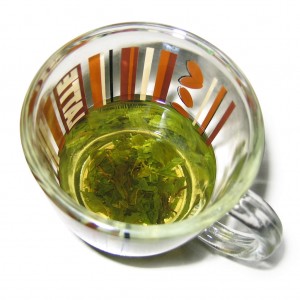People have been drinking and cooking with green tea since 800 A.D. It has been considered a natural healer for the body and soul. The tea plant grows in India, China, and Japan and is cultivated throughout Asia and Indonesia. For centuries, tea has been prescribed as an antidote from depression, various plagues (inhibits growth of cholera, typhoid, and dysentery bacteria). It has even been used to fight tooth decay because it absorbs fluoride from the soil it grows in.
Green and black tea offers protection against cancer and heart disease. The tea has strong antioxidant activity due to the presence of polyphenols. Green tea contains more polyphenols than black tea, which is why it is better to drink. Lastly, green tea contains L-theanine, an amino acid that leaves one feeling alert, but not stimulated.
Researchers at Case Western Reserve University found that green tea may prevent inflammation from injury or from diseases such as arthritis. The antioxidants in green tea inhibit the COX-2 enzyme, which causes inflammation.
Green tea may prevent skin cancer. Research at the University Hospital of Cleveland found that skin damage from UV light was lower when skin was protected by green tea.
Purdue University researchers found that green tea leaves are rich in EGCG; a compound that inhibits an enzyme required for cancer cell growth, and that can kill cultured cancer cells with no ill effect on healthy cells. What an amazing ingredient!
Where does it come from?
Green tea leaves come from the Camellia Sinensis plant. Their leaves are unfermented. The leaves are steamed (blasted with humid hot air) immediately after being picked. The leaves become soft and pliable. The next step is rolling. Moisture is expressed from the leaves to prevent fermentation. After the leaves are rolled they are subjected to another process called firing which continues to reduce the moisture content. It is then packaged and sold.
Andrew Weil, MD recommends drinking four cups of green tea a day for its healthful benefits. His favourite type of green tea is a powdered type called Matcha that is whisked to froth in a tea bowl. It is also used in the Japanese tea ceremony.
In spring, the earliest leaves of the tea plant are picked to make Gyokuro, Japan’s best quality green tea. These dried leaves are ground to a fine dust to make Matcha. Japan’s medium grade green tea is called Sencha. Its leaves are located lower on the plant and are larger.
My personal favourite, Bancha, is made from the lowest, oldest leaves on the plant that includes small twigs.
How to serve Matcha green tea (used in Japanese tea ceremony)
Boil 2 cups water. Remove from heat.
Pour ½ cup water into your teacup to warm it. Empty cup and dry it.
Measure 2 level teaspoons of match powder and place in bottom of cup.
Add 1/3 cup of previous boiled water to cup (just boiled water is too hot, it will wreck the flavour).
Using a small whisk on fork, mix the powder with water. The surface of the tea should be frothy. Drink immediately.





One Response to “Green Tea”